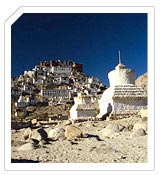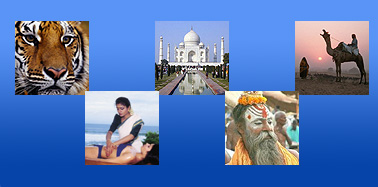|
|
|
|
|
|
|
Home » Hill
Stations in India » Hill Stations in Jammu &
Kashmir » Leh Ladakh
|
|
|
|
Leh Ladakh
|
|
|
|
 Ladakh, the largest of the ten provinces of Jammu and Kashmir is bordered by the Karakorm chain of mountains in the north and Himalayas in the south. Ladakh is the land of towering mountains and Buddhist simplicity. It's beautiful terrains and mountains beckons the adventurous tourist for trekking and mountaineering. The land of jagged peaks and barren landscapes, it is at once alluring and awe-inspiring. Hidden behind this harsh and forbidding facade is an ancient civilization with captivating people. The great Indus river flows right through Ladakh. The province is divided into Leh, the capital, Nubra, Zanskar, lower Ladakh and Rupshu. Ladakh, the largest of the ten provinces of Jammu and Kashmir is bordered by the Karakorm chain of mountains in the north and Himalayas in the south. Ladakh is the land of towering mountains and Buddhist simplicity. It's beautiful terrains and mountains beckons the adventurous tourist for trekking and mountaineering. The land of jagged peaks and barren landscapes, it is at once alluring and awe-inspiring. Hidden behind this harsh and forbidding facade is an ancient civilization with captivating people. The great Indus river flows right through Ladakh. The province is divided into Leh, the capital, Nubra, Zanskar, lower Ladakh and Rupshu.
Sightseeing at Ladakh
Leh : Leh, The capital of Ladakh since the 14th Century is situated at an altitude of 11000 ft. Leh is also a favourite hiking locale and is known for some of the best hikes in the country. The main attraction is the nine storey Leh Palace (Built by Sing ge Namgyal in 16th century) and Tsemo (Victory Peak) built by Tashi Namgyal. The other places of importance are the Sanskar Monastery, Shanti Stupa Zoravar Fort etc. It is also the main business centre of Ladakh. Leh can be subdivided into four main tourist circuits:
Dha-Hanu : It is at a distance of 150 - 170 kms from Leh and is situated at an altitude of 10000 ft. It is the Land of the "Drok-Pa"an Indo Aryan race. Only two villages Dha & Biama are open for tourists. Their cultural and religious practices are totally different from the rest of Ladakh. Bon-Chos believe in an ancient Pre-Buddhist animist religion known as "Bon-Chos".These people abstained from bathing all their lives saying that " If you wash your self,your luck goes away" but since the last few years this practise is beginning to fade away.It has much to offer to scholars in the field of Ethnology&Social Anthropology.
Central Ladakh :This area around river Indus extends from Upshi to Khaltse. This is a very beautiful area with lots of Monasteries and villages. The capital of Ladakh (Leh) also comes under this area. The major attractions are the nine storey Palace (Leh), the Palace Museum of Stok, Hemis, Thiksey, Chemrey, Phyang, Lamayuru, Spituk, Ridzong, Alchi Monasteries and villages of Basgo, Nimoo, Sanskar etc.
 Nubra Valley
:Popularly known as the "Ldomra" or the valley of flowers, it is situated at an altitude of about 10000 ft. The major attraction is the world's highest road ('Khardong la' at 18,380 ft). The capital of Nubra, Diskit is 118 km from Leh. It has a beautiful monastery(founded in 1420) on the hilltop just above the village. Seven kms. from Diskit is the village of Hunder which is very famous for double hump camels, found only in Central Asia and Nubra Valley. Other attractions are the villages of Trith, Sumur, Tegar (Samstangling Monastery ) and Panamik (hot springs). Eight kms from Panamik is Ensa Monastery which is 250 years old and accessible only after a trek of 3-4 hours. Nubra Valley
:Popularly known as the "Ldomra" or the valley of flowers, it is situated at an altitude of about 10000 ft. The major attraction is the world's highest road ('Khardong la' at 18,380 ft). The capital of Nubra, Diskit is 118 km from Leh. It has a beautiful monastery(founded in 1420) on the hilltop just above the village. Seven kms. from Diskit is the village of Hunder which is very famous for double hump camels, found only in Central Asia and Nubra Valley. Other attractions are the villages of Trith, Sumur, Tegar (Samstangling Monastery ) and Panamik (hot springs). Eight kms from Panamik is Ensa Monastery which is 250 years old and accessible only after a trek of 3-4 hours.
Changthang Area :The land of nomad. These tribes are called the "Khampas" or "Chamgpas". There are two race of nomads, one is the 'Ladakhi Nomads' and the other 'Tibetan nomads'. Tibetain nomads wear yak skin and live in movable tents. They can be seen moving around with their herds of yaks, goats, sheep, and cows in search of pasture lands. The area is also famous for its wild life. You may see snow leopards, foxes, wolves wild asses, antelopes, marmots and even some endangered species of birds like the bar headed goose, crested grebe, brahimi ducks, etc.
Suru Valley : The Suru Valley one of the prettiest regions of Ladakh, stretches for 140 kms beyond Kargil to the Penzi La pass, the point of entering into the Zanskar valley. Its verdant hills are intensively cultivated. Enough snow and water during the year sustain two crops annually. The valleys are especially picturesque in spring when they are the Sankoo-Panikhar tract is magnificent. The open valley adorned with undulating alpine meadows strewn with wild flowers, groves of poplars and willows are set against the majestic backdrop of the Himalayan peaks dusted with snow.
Pangong Tso This high salt-water lake, considered to be the highest salt-water lake in the world (certainly in Ladakh!), is at 4300 mtrs in elevation, and is surrounded by mountain peaks over 6500 mtrs high. The lake is extremely long, about 150 km long, but is only a couple of miles (2 km or so) wide -- basically, shaped like a pencil.
|
|
|
|
|
|
| |
|
|
|
|


